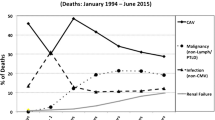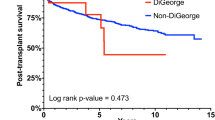Abstract
Amiodarone remains one of the preferred antiarrhythmic medications for patients with advanced heart failure awaiting cardiac transplant. However, the long half-life and rapid redistribution of this agent into donor myocardium expose heart transplant recipients to potential adverse outcomes. In reviewing the current body of literature, we found that pre-operative amiodarone exposure can increase the risk of bradycardia post-transplant; however, this is unlikely to require permanent pacemaker implant. Further, amiodarone has several serious drug–drug interactions with calcineurin inhibitors. Clinicians should therefore consider empiric reduction in initial dosing for tacrolimus or cyclosporine, and carefully monitor blood levels for at least 3 months post-transplant. Although the evidence is conflicting, amiodarone exposure pre-operatively may increase the risk of early graft failure and mortality. Amiodarone use should be minimized whenever possible; if amiodarone cannot practically be discontinued in the pre-transplant phase, judicious monitoring for QTc prolongation and ventricular arrhythmia should be implemented after transplant. As most of the studies included in this review suffered from small sample sizes and limited follow-up, additional research in this area is warranted.
Similar content being viewed by others
References
January CT, Wann LS, Alpert JS et al (2014) AHA/ACC/HRS guideline for the management of patients with atrial fibrillation: a report of the American College of Cardiology/American Heart Association TaskForce on Practice Guidelines and the Heart Rhythm Society. J Am Coll Cardiol 64:e1–e76
Giardina EGV, Schneider M, Barr ML (1990) Myocardial amiodarone and desethylamiodarone concentrations in patients undergoing cardiac transplantation. J Am Coll Cardiol 16(4):943–947
Nanas JN, Anastasioi-Nana MI, Margari ZJ, Karli J, Moulopoulos SD (1997) Redistribution of amiodarone in heart transplant recipients treated with the drug before operation. J Heart Lung Transplant 4:387–389
Belardinelli L, Mattos EC, Berne RM (1981) Evidence of adenosine mediation of atrioventricular block in the ischemic myocardium. J Clin Invest 68:195–205
Montero JA, Anguita M, Concha M et al (1992) Pacing requirements after orthotopic heart transplantation: incidence and related factors. J Heart Lung Transplant 11(4 Pt 1):799–802
Bertolet BD, Eagle DA, Conti JB et al (1996) Bradycardia after heart transplantation: reversal with theophylline. J Am Coll Cardiol 28:396–399
Zimetbaum P (2007) Amiodarone for atrial fibrillation. N Engl J Med 356:935–941
Goldstein DR, Coffey CS, Benza RL et al (2003) Relative perioperative bradycardia does not lead to adverse outcomes after cardiac transplantation. Am J Transplant 3:484–491
Bacal F, Bocchi EA, Vieira MLC et al (2000) Permanent and temporary pacemaker implantation after orthotopic heart transplantation. Arq Bras Cardiol 74:9–12
Zieroth S, Ross H, Rao V et al (2006) Permanent pacing after cardiac transplantation in the era of extended donors. J Heart Lung Tranplant 25(9):1142–1147
Woo GW, Schofield RS, Paul DF et al (2008) Incidence, predictors, and outcomes of cardiac pacing after cardiac transplantation: an 11-year retrospective analysis. Transplantation 85:1216–1218
Manitpisitkul W, McCann E, Lee S, Weir MR (2009) Drug interactions in transplant patients: what everyone should know. Curr Opin Nephrol Hypertens 18(5):404–411
Nalli N, Stewart-Teixeira L, Dipchand AI (2006) Amiodarone–sirolimus/tacrolimus interaction in a pediatric heart transplant patient. Pediatr Transplant 10:736–739
Nicolau DP, Uber WE, Crumbley AJ III, Strange C (1992) Amiodarone-cyclosporine interaction in a heart transplant patient. J Heart Lung Transplant 11(3):564–568
Chitwood KK, Abdul-Haqq AJ, Heim-Duthoy KL (1993) Cyclosporine-amiodarone interaction. Ann Pharmacother 27(5):569–571
Preuner JG, Lehle K, Keyser A, Merk J, Rupprecht L, Goebels R (1998) Development of severe adverse effects after discontinuing amiodarone therapy in human heart transplant recipients. Transplant Proc 30:3943–3944
Kisters K, Cziborra M, Funke C, Brylak S, Hausberg M (2008) Amiodarone-tacrolimus interaction in kidney transplantation. Clin Nephrol 70:563
Schwarz ER, Czer LS, Simsir SA, Kass RM, Trento A (2010) Amiodarone-induced QT prolongation in a newly transplanted heart associated with recurrent ventricular fibrillation. Cardiovasc J Afr 21–2:109–112
Burger CI, Clase CM, Gangji AS (2010) Case report: drug interaction between tacrolimus and amiodarone with QT prolongation. Transplantation 15(89):1166–1167
Macdonald P, Hackworthy R, Keogh A et al (1999) The effect of chronic amiodarone therapy before transplantation on early cardiac allograft function. J Heart Lung Transplant 10(5pt1):743–749
Chelimsky-Fallick C, MIddlekauff HR, Stevenson WG et al (1992) Amiodarone therapy does not compromise subsequent heart transplantation. J Am Coll Cardiol 20(7):1556–1561
Sánchez-Lázaro IJ, Almenar L, Martinez-Dolz L, Chamorro C, Moro J, Agüero J, Rueda J, Zorio E, Arnau MA, Salvador A (2006) Does amiodarone influence early mortality in heart transplantation? Transplantation 38:2537–2538
Chin C, Feindel C, Cheng D (1999) Duration of preoperative amiodarone treatment may be associated with postoperative hospital mortality in patients undergoing heart transplantation. J Cardiothorac Vasc Anesth 13–5:562–566
Blomberg PJ, Feingold D, Denofrio D, Rand W, Konstam MA, Estes M, Link MS (2004) Comparison of survival and other complications after heart transplantation in patients taking amiodarone before surgery versus those not taking amiodarone. Am J Cardiol 93:379–381
Yerebakan H, Naka Y, Sorabella R et al (2014) Amiodarone treatment prior to heart transplantation is associated with acute graft dysfunction and early mortality: a propensity-matched comparison. J Heart Lung Transplant 33:S105
Conflict of interest
D.L.J., B.M., S.M., and D.E.L. have no conflicts of interest to disclose.
Author information
Authors and Affiliations
Corresponding author
Rights and permissions
About this article
Cite this article
Jennings, D.L., Martinez, B., Montalvo, S. et al. Impact of pre-implant amiodarone exposure on outcomes in cardiac transplant recipients. Heart Fail Rev 20, 573–578 (2015). https://doi.org/10.1007/s10741-015-9490-y
Published:
Issue Date:
DOI: https://doi.org/10.1007/s10741-015-9490-y




